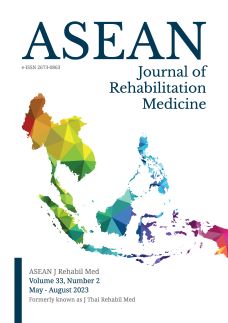The Use of Plastic Ankle-Foot Orthosis Prescribed for Patients with Foot Drop: The Application and Related Factors
Keywords:
foot orthoses, patient compliance, cross-sectional studies, strokeAbstract
Objectives: To study the use patterns and factors related to the use of thermoplastic ankle-foot orthoses (AFO) by patients with foot drop to provide information and to help develop more efficient methods for making decisions regarding the prescription of AFOs.
Study design: Cross-sectional study.
Setting: Department of Rehabilitation Medicine, Maharat Nakhon Ratchasima Hospital.
Subjects: Patients with foot drop who had received thermoplastic AFOs between January 2021 and March 2022.
Methods: Demographics and clinical data were collected from the medical records of the patients. Frequency, duration, and other data related to AFO use were collected via phone interviews with the patients after the AFO had been prescribed for at least 3 months. Use of the AFO was defined as continuous use at least one day a week. Factors associated with compliance with recommended AFO use was analyzed using multivariable analysis.
Results: This study included 117 patients (77 men) with a meanage of 52 years. Of those patients, 59.8% reported continuous use of the AFO with a 95% confidence interval (CI) of 50.8-68.8.
Patients who were unable to do ankle dorsiflexion, who wore clogs and who practiced walking with a physical therapist were more likely to use an AFO with adjusted prevalence ratios (95% CI) of 1.49 (1.04-2.14), 1.75 (1.05-2.93), and 1.45 (1.06-1.98), respectively.
Conclusions: Sixty percent of foot drop patients continued using an AFO after 3 months. Half of those patients used the AFO every day. Being unable to do ankle dorsiflexion, wearing clogs, and practicing walking with a physical therapist were all associated with good compliance with AFO use.
References
Stewart JD. Foot drop: where, why and what to do? Pract Neurol [Internet]. 2008 Jun [cited 2022 Feb 19];8(3):158-69. Available from: https://pubmed.ncbi.nlm.nih.gov/18502948/ doi: 10.1136/jnnp.2008.149393
Hsu J, Michael J, Fisk JMichael J. AAOS Atlas of orthoses and assistive devices. 4th ed. Philadelphia: Mosby; 2008. p. 344.
Fatone S, Gard SA, Malas BS. Effect of ankle-foot orthosis alignment and foot-plate length on the gait of adults with poststroke hemiplegia. Arch Phys Med Rehabil [Internet]. 2009 May [cited 2022 Feb 19];90(5):810-8. Available from: https://pubmed.ncbi.nlm.nih.gov/19406301/ doi: 10.1016/j.apmr.2008.11.012
Kesikburun S, Yavuz F, Güzelküçük Ü, Yaşar E, Balaban B. Effect of ankle foot orthosis on gait parameters and functional ambulation in patients with stroke. Turk J Phys Med Rehabil [Internet]. 2017 Jun [cited 2022 Feb 19];63(2):143-148. Available from: https://pubmed.ncbi.nlm.nih.gov/31453442/ doi: 10.5606/tftrd.2017.129
Richardson JK, Thies SB, DeMott TK, Ashton-Miller JA. Interventions improve gait regularity in patients with peripheral neuropathy while walking on an irregular surface under low light. J Am Geriatr Soc [Internet]. 2004 Apr [cited 2022 Feb 27] ;52(4):510-5. Available from: https://pubmed.ncbi.nlm.nih.gov/15066064/ doi: 10.1111/j.1532-5415.2004.52155.x
Dajpratham P, Pongakkasira C, Terachinda P, Phutthakumnerd W, Sirirak P. Patient compliance and factors related to usage of thermoplastic ankle-foot orthoses by chronic stroke patients. ASEAN J Rehabil Med [Internet]. 2021 [cited 2022 Apr 25];32(1):29-33. Available from: https://www.rehabmed.or.th/main/wp-content/uploads/2022/01/L-518.pdf
Koyuncu E, Nakipoğlu Yüzer GF, Çam P, Özgirgin N. Investigating the status of using lower extremity orthoses recommended to patients with spinal cord injury. Spinal Cord [Internet]. 2016 Nov [cited 2022 Apr 25];54(11):996-1000. Available from: https://pubmed.ncbi.nlm.nih.gov/26976531/ doi: 10.1038/sc.2016.39
de Bruijn IL, Geertzen JH, Dijkstra PU. Functional outcome after peroneal nerve injury. Int J Rehabil Res [Internet]. 2007 Dec [cited 2022 Apr 30];30(4):333-7. Available from: https://pubmed.ncbi.nlm.nih.gov/17975454/ doi: 10.1097/MRR.0b013e3282f14444.
Nakipoğlu Yüzer GF, Koyuncu E, Çam P, Özgirgin N. The regularity of orthosis use and the reasons for disuse in stroke patients. Int J Rehabil Res [Internet]. 2018 Sep [cited 2022 Apr 30];41(3):270-275. Available from: https://pubmed.ncbi.nlm.nih.gov/29939857/ doi: 10.1097/MRR.0000000000000299.
van der Wilk D, Hijmans JM, Postema K, Verkerke GJ. A user-centered qualitative study on experiences with ankle-foot orthoses and suggestions for improved design. Prosthet Orthot Int [Internet]. 2018 Apr [cited 2022 Apr 30];42(2):121-128. Available from: https://pubmed.ncbi.nlm.nih.gov/28100099/ doi: 10.1177/0309364616683981
Sunderland S. The anatomy and physiology of nerve injury. Muscle Nerve [Internet]. 1990 Sep [cited 2022 May 3];13(9):771-84. Available from: https://pubmed.ncbi.nlm.nih.gov/2233864/ doi: 10.1002/mus.880130903
de Wit DC, Buurke JH, Nijlant JM, Ijzerman MJ, Hermens HJ. The effect of an ankle-foot orthosis on walking ability in chronic stroke patients: a randomized controlled trial. Clin Rehabil [Internet]. 2004 Aug [cited 2022 Aug 30];18(5):550-7. Available from: https://pubmed.ncbi.nlm.nih.gov/15293489/ doi: 10.1191/0269215504cr770oa
Doğan A, Mengüllüoğlu M, Özgirgin N. Evaluation of the effect of ankle-foot orthosis use on balance and mobility in hemiparetic stroke patients. Disabil Rehabil [Internet]. 2011 [cited 2022 Aug 30];33(15-16):1433-9. Available from: https://pubmed.ncbi.nlm.nih.gov/21091133/ doi: 10.3109/09638288.2010.533243
Pongpipatpaiboon K, Mukaino M, Matsuda F, Ohtsuka K, Tanikawa H, Yamada J, et al. The impact of ankle-foot orthoses on toe clearance strategy in hemiparetic gait: a cross-sectional study. J Neuroeng Rehabil [Internet]. 2018 May [cited 2022 Sep 10];15(1):41. Available from: https://pubmed.ncbi.nlm.nih.gov/29792211/ doi: 10.1186/s12984-018-0382-y
Churchill AJ, Halligan PW, Wade DT. Relative contribution of footwear to the efficacy of ankle-foot orthoses. Clin Rehabil [Internet]. 2003 Aug [cited 2022 Sep 10];17(5):553-7. Available from: https://pubmed.ncbi.nlm.nih.gov/12952163/ doi: 10.1191/0269215503cr649oa
Farmani F, Mohseni Bandpei MA, Bahramizadeh M, Aminian G, Nikoo MR, Sadeghi-Goghari M. The effect of different shoes on functional mobility and energy expenditure in post-stroke hemiplegic patients using ankle-foot orthosis. Prosthet Orthot Int [Internet]. 2016 Oct [cited 2022 Sep 15];40(5):591-7. Available from: https://pubmed.ncbi.nlm.nih.gov/26184035/ doi: 10.1177/0309364615592704.
Cheskin M. Here’s a comprehensive review of shoe types and proper fitting. Podiatry management [Internet]. 2013 [cited 2022 Sep 25];6(3):109-18. Available from: https://www.podiatrym.com/pdf/2013/11/cheskin1013.pdf
Aprile I, Caliandro P, La Torre G, Tonali P, Foschini M, Mondelli M, et al. Multicenter study of peroneal mononeuropathy: clinical, neurophysiologic, and quality of life assessment. J Peripher Nerv Syst [Internet]. 2005 Sep [cited 2022 Sep 30];10(3):259-68. Available from: https://pubmed.ncbi.nlm.nih.gov/16221285/ doi: 10.1111/j.1085-9489.2005.10304.x.
Downloads
Published
How to Cite
Issue
Section
License

This work is licensed under a Creative Commons Attribution-NonCommercial-NoDerivatives 4.0 International License.






